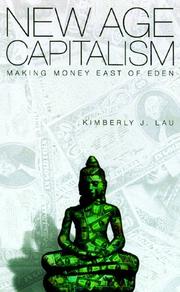| Listing 1 - 10 of 32 | << page >> |
Sort by
|
Periodical
Abstract | Keywords | Export | Availability | Bookmark
 Loading...
Loading...Choose an application
- Reference Manager
- EndNote
- RefWorks (Direct export to RefWorks)
History --- Retail trade --- Commerce de détail --- Periodicals --- Histoire --- Périodiques --- Consumption (Economics) --- Retail trade. --- Retail industry --- Retailing --- Consumer demand --- Consumer spending --- Consumerism --- Spending, Consumer --- Commerce --- Marketing --- Shopping centers --- Wholesale trade --- Demand (Economic theory) --- Geschiedenis
Book
ISBN: 1782978062 1782978089 9781782978084 9781782978060 9781782978077 1782978070 9781782978053 1782978054 Year: 2015 Publisher: Oxford Philadelphia
Abstract | Keywords | Export | Availability | Bookmark
 Loading...
Loading...Choose an application
- Reference Manager
- EndNote
- RefWorks (Direct export to RefWorks)
The medieval marketplace is a familiar setting in popular and academic accounts of the Middle Ages, but we actually know very little about the people involved in the transactions that took place there, how their lives were influenced by those transactions, or about the complex networks of individuals whose actions allowed raw materials to be extracted, hewn into objects, stored and ultimately shipped for market. Twenty diverse case studies combine leading edge techniques and novel theoretical approaches to illuminate the identities and lives of these much overlooked ordinary people, painting o
Handicraft --- Artisans --- Consumption (Economics) --- Consumer demand --- Consumer spending --- Consumerism --- Spending, Consumer --- Demand (Economic theory) --- Artizans --- Craftsmen --- Craftspeople --- Craftspersons --- Skilled labor --- Cottage industries --- Crafts (Handicrafts) --- Handcraft --- Occupations --- Decorative arts --- Manual training --- Sloyd --- History.
Book
ISBN: 0817389083 9780817389086 9780817318901 0817318909 Year: 2015 Publisher: Tuscaloosa, Alabama
Abstract | Keywords | Export | Availability | Bookmark
 Loading...
Loading...Choose an application
- Reference Manager
- EndNote
- RefWorks (Direct export to RefWorks)
The essays in this work examine how consumer culture both constrains and empowers contemporary motherhood. The collection demonstrates that the logic of consumerism and entrepreneurship has redefined both the experience of mothering and the marketplace. The Motherhood Business follows the harried mother's path into the anxious maelstrom of intelligent toys, healthy foods and meals, and educational choices. It also traces how some enterprising mothers leverage cultural capital and rhetorical vision to create thriving baby- and child-based businesses of their own, as evidenced by the rise of mommy bloggers and "mompreneurs" over the last decade.
Consumption (Economics) --- Mothers. --- Motherhood --- Consumer demand --- Consumer spending --- Consumerism --- Spending, Consumer --- Demand (Economic theory) --- Moms --- Parents --- Women --- Housewives --- Pregnant women --- Maternity --- Mothers --- Parenthood --- Social aspects. --- Economic aspects. --- Social aspects --- Economic aspects --- E-books

ISBN: 9781933588216 1933588217 142942771X Year: 2015 Publisher: Amityville New Strategist Press, LLC
Abstract | Keywords | Export | Availability | Bookmark
 Loading...
Loading...Choose an application
- Reference Manager
- EndNote
- RefWorks (Direct export to RefWorks)
Find out how the American marketplace has been transformed by the Great Recession in the new 11th edition of Best Customers: Demographics of Consumer Demand, with all-important 2013 spending data. Best Customers is a unique look at who the best and biggest customers are for hundreds of individual products and services. The new edition of Best Customers includes analyses of spending trends before (2000 to 2006) and after (2006 to 2013) the Great Recession, product by product.Best Customers analyzes household spending on more than 300 products and services by age of householder, household income, household type, race and Hispanic origin of householder, region of residence, and educational attainment of householder. Based on unpublished data from the 2013 Consumer Expenditure Survey--you can't find this on the Internet--Best Customers identifies which households spend the most on a product or service (the best customers) and which control the largest share of spending (the biggest customers).Best Customers is divided into 21 chapters, arranged alphabetically. Within each chapter, individual products and services are arranged alphabetically. The chapters are: alcoholic beverages, apparel, computers, education, entertainment, financial products and services, household furnishings, gifts to non-household members, groceries, health care, household services, housekeeping supplies,a personal care products and services, reading material, restaurants and carry-outs, shelter and utilities, telephone, tobacco, transportation, travel, and utilities.Each table in Best Customers analyzes household spending on a particular product or service and is accompanied by text identifying the best and biggest customers, analyzing spending patterns, describing spending trends before and after the Great Recession, and predicting future trends based on the nation's changing demographics. INTENDED AUDIENCE: Marketers, advertisers, small businesses, large corporations, entrepreneurs, consultants, business students, and the libraries that serve them. It is a one-of-a-kind resource for those who need to understand the dynamics of the American marketplace.
Consumption (Economics) --- Consumers --- Consumer behavior --- Behavior, Consumer --- Buyer behavior --- Decision making, Consumer --- Human behavior --- Consumer profiling --- Market surveys --- Consumer demand --- Consumer spending --- Consumerism --- Spending, Consumer --- Demand (Economic theory) --- E-books --- Reference Books --- Reference
Book
ISBN: 9780745661278 9780745661285 0745661289 0745661270 Year: 2015 Publisher: Cambridge Polity
Abstract | Keywords | Export | Availability | Bookmark
 Loading...
Loading...Choose an application
- Reference Manager
- EndNote
- RefWorks (Direct export to RefWorks)
The Sociology of Consumption: A Global Approach offers college students, scholars, and interested readers a state-of-the-art overview of consumption the desire for, purchase, use, display, exchange, and disposal of goods and services. The book's global focus, emphasis on social inequality, and analysis of consumer citizenship offer a timely, exciting, and original approach to the topic. Looking beyond the U.S. and Europe, Stillerman engages examples from his and others' research in Chile and other Latin American countries, Europe, the Middle East, Africa, and East and South Asia to explore the interaction between global and local forces in consumption. The text explores the lived experience of being a consumer, demonstrating how social inequalities based on class, gender, sexuality, race, and age shape consumer practices and identities. Finally, the book uncovers the important role consumption has played in fueling local and international activism. This welcome new book will be ideal for classes on consumer culture across the social sciences, humanities, and marketing.--
Consumer behavior --- Sociology of culture --- Consumption (Economics) --- Consommation (Economie politique) --- Consommateurs --- Social aspects --- Aspect social --- Comportement --- Consumer behavior. --- Social aspects. --- 366.1 --- Behavior, Consumer --- Buyer behavior --- Decision making, Consumer --- Human behavior --- Consumer profiling --- Market surveys --- Consumer demand --- Consumer spending --- Consumerism --- Spending, Consumer --- Demand (Economic theory) --- consumentengedrag --- Consommation --- Inégalité sociale --- Sociologie --- Attitudes. --- Attitude (psychologie) --- Inégalité sociale. --- Sociologie. --- Attitude. --- Inégalité sociale.

ISBN: 9780812217292 0812235487 9780812235487 0812217292 1512820016 Year: 2015 Publisher: Philadelphia : University of Pennsylvania Press,
Abstract | Keywords | Export | Availability | Bookmark
 Loading...
Loading...Choose an application
- Reference Manager
- EndNote
- RefWorks (Direct export to RefWorks)
The pursuit of health and wellness has become a fundamental and familiar part of everyday life in America. We are surrounded by an enticing world of products, practices, and promotions assuring health and happiness-cereal boxes claim that their contents can reduce the risk of heart disease, bars of aromatherapy soap seek to wash away our stresses, newspapers celebrate the wonders of the latest superfoods and herbal remedies. No longer confined to the domain of Western medicine, suggestions for healthy living often turn to alternatives originating in distant times and places, in cultures very different from our own. Diets from ancient or remote groups are presented as cures for everything from colds to cancer; exercise regimens based on Eastern philosophies are heralded as paths to physical health and spiritual wellbeing.In New Age Capitalism, Kimberly Lau examines the ideological work that has created this billion-dollar business and allowed "Eastern" and other non-Western traditions to be coopted by Western capitalism. Extending the orientalist logic to the business of health and wellness, American companies have created a lucrative and competitive market for their products, encouraging consumers to believe that they are making the right choices for personal as well as planetary health. In reality, alternative health practices have been commodified for an American public longing not only for health and wellness but also for authenticity, tradition, and a connection to the cultures of an imagined Edenic past. Although consumers might prefer to buy into "authentic" non-Western therapies, New Age Capitalism argues that the market economy makes this goal unattainable.
New age consumers --- Capitalism --- Consumption (Economics) --- Marketing --- New Age --- Verbraucherverhalten --- Social aspects --- USA --- New Age. --- Verbraucherverhalten. --- USA. --- Consumers --- Market economy --- Economics --- Profit --- Capital --- Consumer demand --- Consumer spending --- Consumerism --- Spending, Consumer --- Demand (Economic theory) --- Anthropology. --- Business. --- Caregiving. --- Cultural Studies. --- Economics. --- Folklore. --- Health. --- Linguistics. --- Literature. --- Medicine.
Book
ISBN: 9781785603228 1785603221 178560323X 9781785603235 9781780521176 1780521170 9781780521169 1780521162 1283354756 9786613354754 Year: 2015 Publisher: Bingley
Abstract | Keywords | Export | Availability | Bookmark
 Loading...
Loading...Choose an application
- Reference Manager
- EndNote
- RefWorks (Direct export to RefWorks)
Research in Consumer Behavior presents cutting edge consumer research, whether empirical or conceptual, qualitative or quantitative. The majority of papers in this volume have been selected from the best papers at the 2011 Consumer Culture Theory Conference held in Chicago Illinois in July, 2011. The Conference is the premier event for consumer culture research which tends to be qualitative, ethnographic, and cultural in orientation and draws a variety of scholars from around the world. Many of these scholars are housed in academic marketing department, but they also come from fields of anthropology, sociology, cultural studies, and communications as well as from industry. The papers selected for this volume are those judged to be the best among those selected for the conference from submissions to the conference peer review. This marks the third volume of Research in Consumer Behavior that has been able to publish the top Consumer Culture Theory papers.
E-books --- Consumption (Economics) --- Consumer behavior --- Social aspects --- Consumer demand --- Consumer spending --- Consumerism --- Spending, Consumer --- Demand (Economic theory) --- National consumption --- Sociology of culture --- Behavior, Consumer --- Buyer behavior --- Decision making, Consumer --- Human behavior --- Consumer profiling --- Market surveys --- Research --- Business & Economics --- Behavioural theory (Behaviourism) --- Marketing --- General. --- Sales & marketing. --- Market research. --- Research. --- Consumer Behavior. --- Branding (Marketing) --- Culture --- Economic aspects

ISBN: 0801454271 0801437237 080145672X 0801454263 9780801454271 9780801456725 9780801454264 Year: 2015 Publisher: Ithaca
Abstract | Keywords | Export | Availability | Bookmark
 Loading...
Loading...Choose an application
- Reference Manager
- EndNote
- RefWorks (Direct export to RefWorks)
With unprecedented subtlety, compassion and richness of detail, Susan Porter Benson takes readers into the budgets and the lives of working-class families in the United States between the two world wars. Focusing on families from regions across America and of differing races and ethnicities, she argues that working-class families of the time were not on the verge of entering the middle class and embracing mass culture. Rather, she contends that during the interwar period such families lived in a context of scarcity and limited resources, not plenty. Their consumption, Benson argues, revolved around hard choices about basic needs and provided therapeutic satisfactions only secondarily, if at all. Household Accounts is rich with details Benson gathered from previously untapped sources, particularly interviews with women wage earners conducted by field agents of the Women's Bureau of the Department of Labor. She provides a vivid picture of a working-class culture of family consumption: how working-class families negotiated funds; how they made qualitative decisions about what they wanted; how they determined financial strategies and individual goals; and how, in short, families made ends meet during this period. Topics usually central to the histories of consumption-he development of mass consumer culture, the hegemony of middle-class versions of consumption, and the expanded offerings of the marketplace-contributed to but did not control the lives of working-class people. Ultimately, Household Accounts seriously calls into question the usual narrative of a rising and inclusive tide of twentieth-century consumption.
Households --- Families --- Working class --- Consumption (Economics) --- Economic aspects --- History --- United States --- Economic conditions --- Consumer demand --- Consumer spending --- Consumerism --- Spending, Consumer --- Family --- Family life --- Family relationships --- Family structure --- Relationships, Family --- Structure, Family --- Social aspects --- Social conditions --- Demand (Economic theory) --- Social institutions --- Birth order --- Domestic relations --- Home --- Kinship --- Marriage --- Matriarchy --- Parenthood --- Patriarchy --- Population --- Home economics --- E-books
Book
ISBN: 0691041016 069162495X 1400879698 9781400879694 9780691041018 9780691624952 Year: 2015 Publisher: Princeton, NJ
Abstract | Keywords | Export | Availability | Bookmark
 Loading...
Loading...Choose an application
- Reference Manager
- EndNote
- RefWorks (Direct export to RefWorks)
The author is concerned with whether or not surveys of consumer anticipations can improve predictions of purchase behavior relative to predictions that use only objective variables obtainable at the same date. The basic objective of the study is improved predictions of changes over time.Originally published in 1964.The Princeton Legacy Library uses the latest print-on-demand technology to again make available previously out-of-print books from the distinguished backlist of Princeton University Press. These editions preserve the original texts of these important books while presenting them in durable paperback and hardcover editions. The goal of the Princeton Legacy Library is to vastly increase access to the rich scholarly heritage found in the thousands of books published by Princeton University Press since its founding in 1905.
Consumption (Economics) --- Consumers --- Business forecasting. --- Durable goods, Consumer. --- Consumer durable goods --- Durables --- Consumer goods --- Nondurable goods --- Business --- Business forecasts --- Forecasting, Business --- Economic forecasting --- Consumer demand --- Consumer spending --- Consumerism --- Spending, Consumer --- Demand (Economic theory) --- Forecasting --- Business forecasting --- Durable goods, Consumer --- E-books
Book
ISBN: 9780415694391 0415694396 9780203147870 9781136511790 9781136511745 9781136511783 9781138645356 Year: 2015 Publisher: New York, N.Y. Routledge
Abstract | Keywords | Export | Availability | Bookmark
 Loading...
Loading...Choose an application
- Reference Manager
- EndNote
- RefWorks (Direct export to RefWorks)
"The book explores the vital role played by the financial service industries in enabling the poor to consume over the last hundred and fifty years. Spending requires means, but these industries offered something else as well - they offered practical marketing devices that captured, captivated and enticed poor consumers. Consumption and consumer markets depend on such devices but their role has been poorly understood both in the social sciences and in business studies and marketing. While the analysis of consumption and markets has been carved up between academics and practitioners who have been interested in either their social and cultural life or their economic and commercial organization, consumption continues to be driven by their combination. Devising consumption requires practical mixtures of commerce and art whether the product is an insurance policy or the next gadget in the internet of things . By making the case for a pragmatic understanding of how ordinary, everyday consumption is orchestrated, the book offers an alternative to orthodox approaches, which should appeal to interdisciplinary audiences interested in questions about how markets work and why it matters"--
Financial services industry --- Consumption (Economics) --- Low-income consumers. --- #SBIB:316.334.2A60 --- #SBIB:309H2812 --- Disadvantaged consumers --- Poor as consumers --- Consumers --- Consumer demand --- Consumer spending --- Consumerism --- Spending, Consumer --- Demand (Economic theory) --- Services, Financial --- Service industries --- History. --- Economische sociologie --- Marketing, consumentengedrag, consumentisme --- Private finance --- Consumer behavior --- Low-income consumers --- History
| Listing 1 - 10 of 32 | << page >> |
Sort by
|

 Search
Search Feedback
Feedback About UniCat
About UniCat  Help
Help News
News